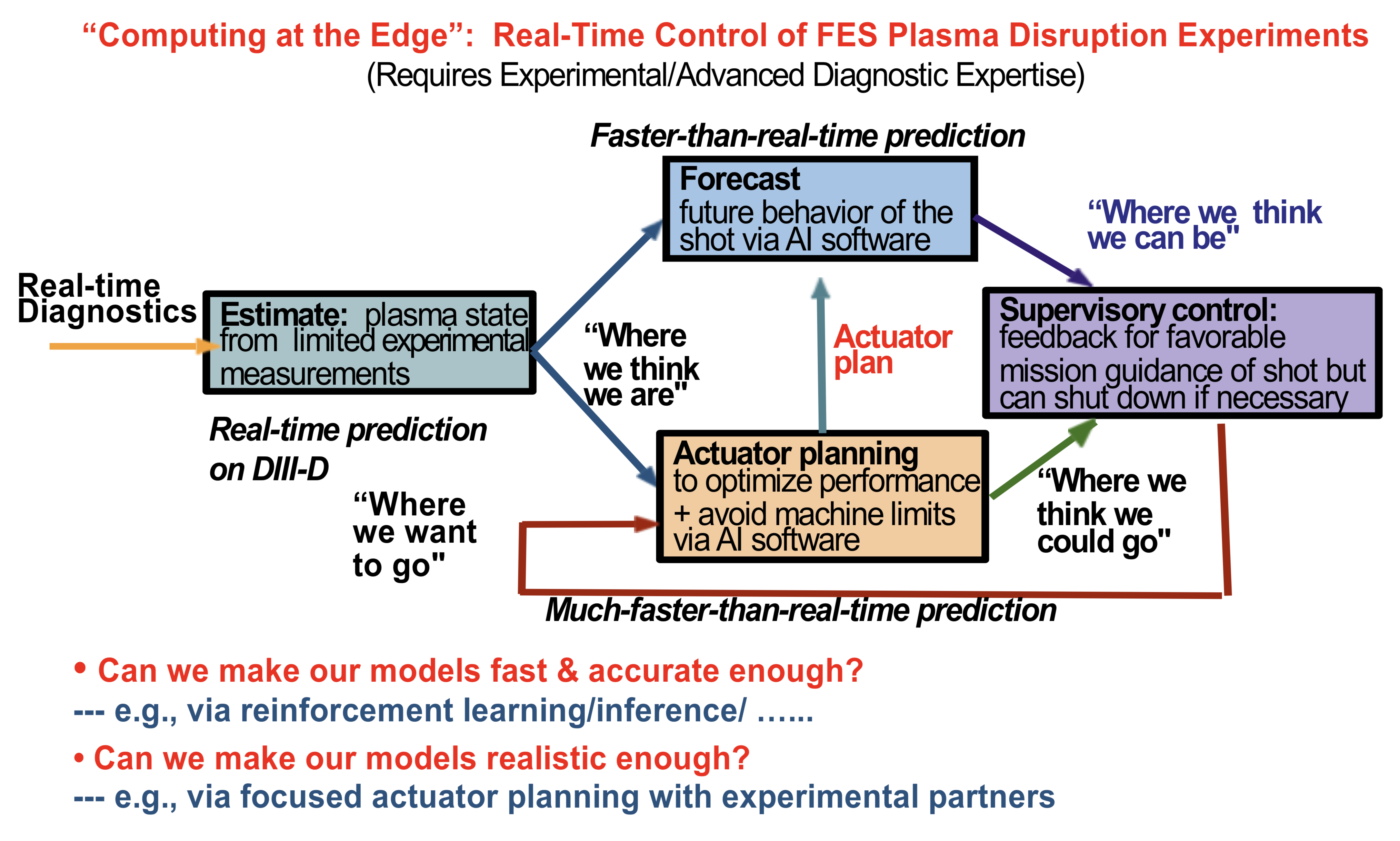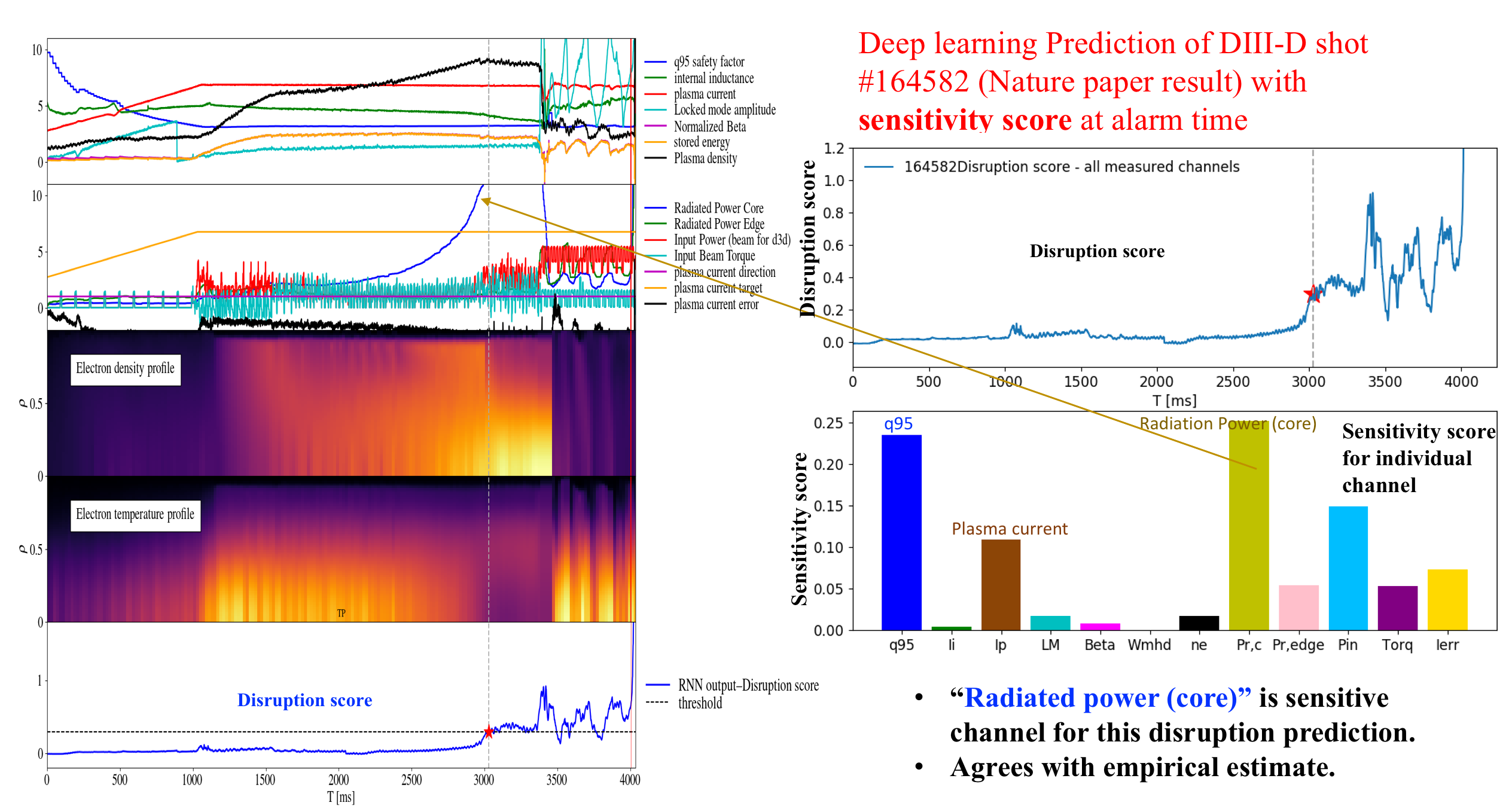Speaker
Description
State-of-the-art deep-learning disruption prediction models based on the Fusion Recurrent Neural Network (FRNN) (1) have been further improved. Here we report the new capability of the software to output not only the “disruption score,” as an indicator of the probability of an imminent disruption, but also a “sensitivity score” in real-time to indicate the underlying reasons for the imminent disruption. As an indicator of possible causes for future disruptions, the “sensitivity score” can provide valuable physics-based interpretability for the deep-learning model results, and more importantly, provide targeted guidance for the control actuators when implemented into any modern Plasma Control System (PCS). This achievement represents a significant step forward in moving from modern deep-learning disruption prediction to real-time control— a major advance since the last IAEA meeting— that brings novel AI-enabled capabilities needed for the future burning plasma ITER system.
The main findings in this paper all help address the basic issue/perception that advanced Machine Learning/Deep learning methods are generally hard to interpret. Results presented used large amounts of data from JET and DIII-D congruent with publications such as prominent deep learning NATURE paper (1). Moving beyond this work on tokamak disruptions, the current IAEA paper addresses and answers in addition to “when” a shot is going to disrupt, some compelling reasons to explain “why” it disrupts by carrying out sensitivity studies.
A new scheme as shown in Fig. 1 is introduced in which control of actuators can be engaged by AI-enabled disruption predictors. The FRNN code used 16 total – including 14 zero-D scalar signals and two 1D profile signals. In this total of 16 channels, 5 are post-processed data with the remaining 11 channels being real-time data. We have obtained the real-time “point names” for all 16 signals and have subsequently focused on training the prediction model based on the real-time data for control purposes.
We highlight here the fact that the FRNN deep learning code can be readily extended to using many more channels of information. For example, some DIII-D signals that are known to be highly relevant physics-based channels are: (i) “n1rms” – a signal correlated with the activities of the n =1 modes with finite frequency, including the neoclassical tearing modes (NTMs) and sawtooth; (ii) the bolometer data that reflects the impurity content of the plasma; and (iii) “q- min” – the minimum value of the safety factor which directly relates to important physics such as the kink modes. These considerations have strongly motivated us to include the associated channels directly into the improved performance development of the deep learning FRNN software with the goal of clearer identification of the physics most responsible for the dangerous disruption events with associated guidance toward targeted guidance for the control actuators. The potential for significant improvement over existing traditional algorithms targeting these signals for plasma condition and disruption control comes from the fact that deep-learning/AI models have the distinct advantage of being able to carry out supercomputing-enabled robust predictions for complex physical systems with a huge number of potentially correlated features, without the necessity of manual “feature engineering”. This enables the capability to deliver predictions for unseen conditions, such as new plasma parameters including those associated with future larger devices. Moreover, another key advantage of deep-learning enabled predictive capabilities is the ability to carry out forecasts significantly earlier in the evolution of the plasma state under consideration, especially when more physics-based channels are included in the model input. For example, in preliminary recent studies, the average alarm time for FRNN disruption predictions from models trained with the n=1 mode amplitude channel can be around 100 ms earlier than that from models trained without this information. The basic enabling capabilities with deep learning FRNN performance on large databases were established and explained previously (1).
Overall, the key point made in this paper is that when more physics related channels are included, valuable new insights can be gained on the mechanisms contributing to disruptions. For example,
in the right upper panel of Fig. 2, the evolution of the FRNN disruption score for DIII-D shot #164582 is displayed. While this score rises above the disruption alarm threshold at around 3000ms, such information alone would only enable the PCS to respond in a single and preprogrammed way -- such as injecting gas to terminate the shot. In contrast, our new real-time sensitivity score (shown on the right lower panel) clearly indicates that FRNN can categorize this potentially dangerous plasma condition as being impurity related, which could in turn lead to tearing modes and locked modes that did in fact show up later in the shot at around 3400 ms (as indicated by the cyan-colored line in the left top panel). Therefore, FRNN is demonstrably able to construct much more efficient real-time strategies for the PCS; i.e., in this instance, it could initiate actuator control to reduce impurities or weaken tearing modes impact. In addition, it is found that different shots could have completely different sensitivity score distributions at alarm time. Consequently, in future work, with more data from the control actuators together with the aid of proper plasma simulators, FRNN can be developed to: (i) construct a tree-shape “policy network” for the different actuators in the PCS; and (ii) update this tree at each time step according to the feedback from real-time plasma dynamics. The overall impact here would be the capability to output the best real-time strategy for keeping the plasma in a disruption-free regime for a significant duration.
Summarily, in addition to providing a robust “disruption score,” the present deep learning studies compute a “sensitivity score” for each physics-connected channel (as shown in Fig. 2). In addition to studying the physics in subcategories (2) of disruptions, these “sensitivity scores” for each channel can also indicate the detailed reason for the coming disruption, and in turn provide guidance to the PCS with more precise and direct information for the control actuators.


(1) J. Kates-Harbeck, A. Svyatkovskiy, W.Tang, Nature 568 (7753), 526; (2) P.C. de Vries, et al, Nucl. Fusion, 51, 053018.
This material is based upon work supported by the U.S. Department of Energy, Office of Science, Office of Fusion Energy Sciences, using the DIII-D National Fusion Facility, a DOE Office of Science user facility, under Awards DE-FC02-04ER54698; DE-AC02-09CH11466
| Affiliation | Princeton Plasma Physics Laboratory |
|---|---|
| Country or International Organization | United States |
